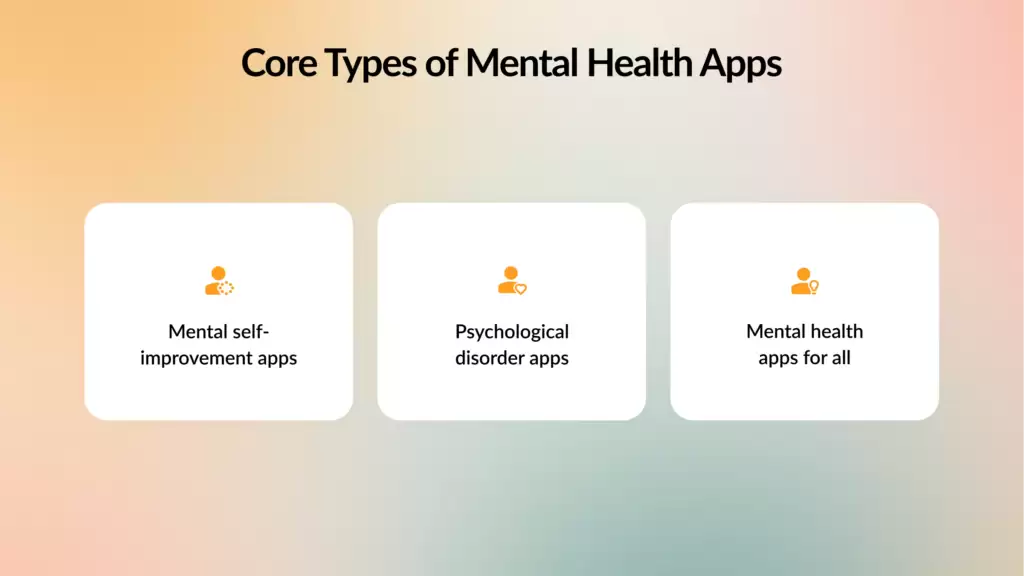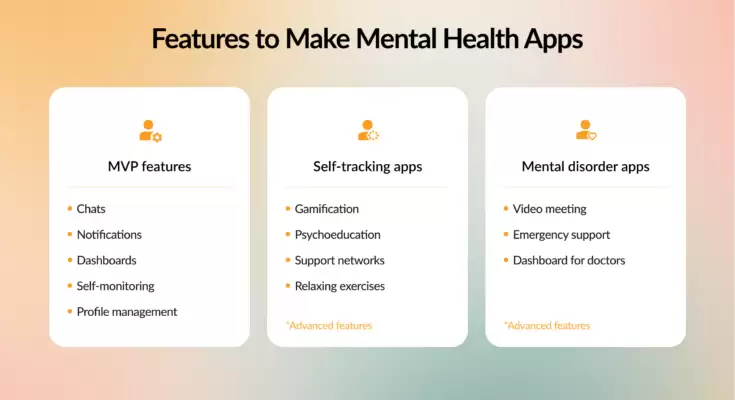The digitalization of medicine increased the opportunities to care for mental health. Having round-the-clock communication with a therapist using a mobile application made such software viral. This article will tell you what to consider when developing mental health apps, how much they will cost, and how you can benefit from them.
Demand for Mental Healthcare
Every year, more than abillion peopleworldwide face mental health problems. Not all of them can see a doctor for various reasons: someone is afraid of condemnation, does not know where to find a qualified specialist, etc. On the other hand, some people need psychological support to maintain morale and cope with anxiety. Statistics show that users’ spending on mental health apps increased by$119 millionbetween 2021 and 2022.
We can conclude that the creation of such applications now can bring many benefits since they have several advantages:
Availability of medical consultations.Mobile applications allow receiving quality service from any place. It is enough for the user to access the Internet to contact a psychologist who will help with their problem.
Quick access to medical help.Mental health apps allow the patient to receive urgent advice if needed.
Improved interaction efficiency.The use of tools like push notifications helps to interact with patients more effectively, notifying them of scheduled consultations and offering additional services that may interest clients.
These factors benefit both parties: customers and providers of medical services.

Types of Mental Health Apps
There are three basic types of mental health apps. Let’s consider in more detail:
Pic.Core types of mental health apps
Self-development applications
This software is designed for mentally healthy people who want to improve their quality of life. They serve for:
- Tracking mood.Such applications help people track their well-being daily and note the factors influencing their mood changes.
- Eliminating stress.This software allows people to better manage stress by providing access to relaxing mini-games and meditations.
- Fighting bad habits.Apps of this type offer people unique programs to eliminate bad habits and negative thoughts.
Applications for the treatment of mental disorders
This type necessarily contains the possibility of direct communication with specialists. The application provides round-the-clock contact with experts, online consultations, and chats. The primary purpose of such software is to help eliminate mental illness.
Telemedicine apps
This type combines the previous two and provides various courses and practices for people who care about their mental health and specialists’ help for those who need it.
When deciding which type of application to use for your app, consider your desired target audience. For example, if you want your software to be helpful for everyone, considertelemedicine software development.
Monetization types
When it comes to monetizing mental health apps, there are some standard options:
- Freemium.Using this model, you provide basic functionality for free, but access to premium features is provided on a paid basis.
- Subscriptions.You can provide access to the features of your application based on monthly or annual subscriptions.
- Advertising.In-app advertising is still commonly-used as it allows you to profit from integrations by providing services for free.
In addition to the listed, you can use any other monetization model that seems most profitable.
Must-Have Features
Let’s consider the basic functionality of the mental help app:
Pic.Must-have mental health app features
- Self-monitoring.Regardless of the purpose of the application, the ability to track the current state is an essential component.
- Messengers.Implementing the possibility of direct communication between the user and the healthcare professional or support staff is critical.
- Notifications.It is crucial to keep in touch with users and communicate important information.
- Personal profile.It should be convenient for the users to provide and change information about themselves.
- Dashboards.It’s a good idea for users to track their progress, motivating them to keep working on themselves.
- Registration.It is worth adding the ability to create an account in the simplest possible ways, such as by email, phone number, or social networks.
You may also add some extra features to increase users’ satisfaction, for example:
- Relaxation practices.A great way to help the user de-stress after a long day and feel better.
- Educational materials.You can add articles and videos teaching mental illness prevention for those who may be interested in this topic.
- Urgent support.For those who suffer from panic attacks or anxiety attacks, you can add a 24-hour assistant to help you get out of acute conditions.
Mental health is quite a delicate topic, and there are many different ways to work with it, so you can also add any other features that you find helpful.
Pitfalls of Mental Health App Creation
There are also some details to pay attention to when developing a mental health app.
Data protection
As cyber-attacks are constantly rising, special attention should be paid to security. Therefore, when choosing a technical partner, carefully analyze how much attention he pays to protect the application.
Legal details
Most apps do not contain Protected Health Information (PHI). However, in the case of applications for the treatment of psychiatric disorders, you need to adhere to specific privacy laws.
Online therapy
Although video calls are the most common type of online consultation, some users will prefer to communicate with a therapist via chat, voice calls, or mail. Therefore, it is worth considering when developing.
Cost to Build a Mental Health App
Another critical issue is the cost of the mental health app. It depends on development time and the developer’s hourly rate. The most profitable option is to cooperate with outsourcing companies in the CEE region, whose hourly rate is around $50, and the quality of development is at its best.
As for the development, the application goes through an inevitable life cycle, which includes:
1.Discovery phase.Determining all project details, discussing technical requirements, and designing prototypes.
2.UI/UX design.Creating an application interface screen by screen.
3.Development.Writing code and creating working applications.
4.Quality Assurance.Testing the application for bugs and errors to fix them.
5.Deployment.The finished application will be released to marketplaces.
6.Maintenance.Released product technical support, updates, and fixes.
On average, a mental health app that ran through the entire development process costs between $60,000 and $150,000. However, for an accurate estimate, you should contact the software vendor.
Wrapping Up
Today, people focus on their mental health and pay a lot of attention to it, which is why mental health apps are gaining immense popularity. If you want to expand your services and make them mobile or want to create a startup, building a mental health app is a great idea. So it is worth contacting an experienced software provider who will help turn your vision into reality.
Yuliya Melnik is a technical writer at Cleveroad. It is a web and mobile app development company in Ukraine. She is passionate about innovative technologies that make the world a better place and loves creating content that evokes vivid emotions.
